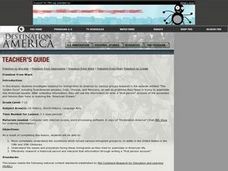Curated OER
Working for a Living: Child Labor Laws
Students research the working conditions in the late 1800's and the evolution of child labor laws. They discuss how the laws affect them today and if they are fair. They write a paper summarizing the laws and the view of the laws.
Curated OER
Labor Needs in Colonial America
Students examine the labor needs in colonial America. Using primary and secondary resources, they explore the major events and life in the United States during colonial times. They complete a chart listing the pros and cons of a slave...
Curated OER
Immigration to the United States
Learners examine the reasons why people immigrated to the United States. Using maps and charts, they analyze population movements and religious affiliations. They discover how the United States became a lesser Protestant country.
Constitutional Rights Foundation
Unemployment and the Future of Jobs in America
Unemployment: The job of the future. The resource, designed for high school scholars, explains unemployment rates, recessions, and job trends that are impacting employment in the United States. Academics explore potential careers of the...
Curated OER
Federal Holidays
Third graders complete various activities pertaining to Martin Luther King Jr. Day, Presidents' Day, Memorial Day, Labor Day, Columbus Day, and Veteran's Day. They conduct research and complete writing and art activities on the...
National First Ladies' Library
Workers, Take a Holiday! the Beginning of Labor Day
When your upper elementary class returns in the fall, have them identify and define the beginnings of the labor movement and Labor Day in the United States. They thoughtfully reflect on changes that have occurred in the way we think...
Curated OER
Cotton And Child Labor
Eleventh graders investigate the practice of child labor as found in the history of the United States. The teacher reads the class a story from the year of 1914. This creates context for the lesson and then students answer teacher...
ProCon
Cuba Embargo
President John F. Kennedy bought 1,200 Cuban cigars the night before he enacted the Cuban trade embargo in 1962. Should the United States maintain the embargo? Using the website, pupils explore the topic to prepare for a class debate or...
Curated OER
Will You Pick My Cotton?
Use this cross-curricular history lesson to work on your learners' informational writing skills. After listening to songs and stories related to Sultana, they engage in a several activities to boost their understanding of slavery and...
Curated OER
The American Civil War (1861 -1864)
Peek back in time and learn about the North and South of the American Civil War. Discussed in full are the causes, effects, major battles, and agreements that made Civil War history. Period technology, social changes, and the ultimate...
Curated OER
Freedom Voices: Abolition and Suffrage in the United States
Students explore abolition and suffrage in the United States.
Curated OER
Slavery in the United States
Students investigate the personal accounts of slaves in the United States. They participate in various activities according to grade level to examine the role of slavery in the South.
Curated OER
Mexican American Labor in the U.S.
Ninth graders examine how the United States historically shifts policies toward Mexican and Mexican American laborers to acquire cheap, temporary labor. In this US History activity, 9th graders research the history of immigration from...
Curated OER
Labor History in the United States
Eleventh graders read several articles regarding ethics and ethical behavior. They analyze the reasons for tragedies and circumstances surrounding the relationships between labor and owners. In small groups, 11th graders write a report...
Curated OER
Leaders, Laborers, and Other Perspectives of World War II
How did the women in France feel about their country’s involvement in World War II? Class groups are assigned a country involved in WWII, and individuals within the group adopt the point of view of leaders, laborers, businessmen, women,...
Stanford University
Chinese Immigration and Exclusion
The Chinese Exclusion Act was the first race-based restriction on immigration in American history. Why was the act passed after Chinese immigrants helped build the Transcontinental Railroad? A series of documents, including speeches and...
Teaching Tolerance
Slavery as a Form of Racialized Social Control
An engaging lesson delves into the effects of slavery on society. Young historians read text excerpts, complete handouts, and participate in group discussion to understand how slavery was a means to control society and establish a racial...
Weebly
Ancient China
From China's physical geography and earliest beginnings of civilization to the Qin and Han dynasties, here is a nicely designed worksheet on ancient China, which includes a graphic organizer and timeline to summarize the reading...
Curated OER
Oral History of World War II
Learners research how citizens from the United States respond to the onset, duration and aftermath of World War II. They view clips from the movie "Swing Shift" and discuss the roles of civilians, minorities and military personnel. They...
Curated OER
Immigration to America
Students examine reasons for immigration to the United States in the 19th century. They role play as immigrants asked to write accounts of their immigrant experiences.
Curated OER
Border to Border
Students use the Internet to gather information on the country of Mexico. They also discover the culture of their people and compare them with the United States population. They take a virtual tour of some of Mexico's most historical ruins.
Curated OER
Child Labor in America
Students interpret historical evidence presented in primary and secondary sources. In this child labor lesson plan, students examine the issue of child labor and determine how citizen action...
Syracuse University
American Industrial Revolution
While the Industrial Revolution may have fueled America's rise to the top of world markets, the child laborers often faced dangerous conditions. Using primary source images and other information, scholars consider what these children...

























